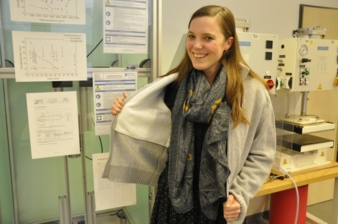07/02/2016 — auf Deutsch lesen
Protection against knife attacks
Taxi drivers, bus drivers, and staff in employment agencies all have one thing in common: They are all regularly exposed to situations in which they could become victims of a knife attack. At the Research Institute for Textiles and Clothing (Forschungsinstitut für Textil und Bekleidung, FTB) at the Niederrhein University of Applied Sciences, scientists are working on an uncomplicated method of protection: A cardigan with integrated stab protection will also be fitted with a sensor that detects a knife attack and then transmits a signal.
The stab-proof cardigan was developed between 2012 and 2014 by the scientists at the FTB in collaboration with a knitwear manufacturer from Rheinberg. In terms of design, it is built in a similar way to a medieval coat of chainmail – only instead of steel, high-strength polyethylene is used. The yarn used is also extremely resistant to cuts and tears. Stab protection is achieved by means of a multi-layered, knitted insert, which is integrated into the cardigan. Due to its design as an item of knitwear, the cardigan retains its flexibility and good level of comfort even with the insert. Using a purpose-built testing station, a particularly sharp and pointed knife strikes the cardigan with a defined energy of 25 Joules, and the depth of penetration is measured. If the penetration depth is less than two centimetres, then the textile conforms to a recognised standard. Susanne Aumann, a scientist who collaborated on the project, prefers to speak of the cardigan’s “stab resistant” properties, as one hundred percent protection is difficult to guarantee.
Its successor project should also be viewed within this context: “We want to install an additional layer with a sensor, which, in the event of an attack, would send a signal and trigger an emergency call, for example,” said Evelyn Lempa, who has been researching conductive textiles for several years. The research project, which was started on 1 January 2015, has received EUR 175,000 in funding for two years within the scope of the Central Innovation Programme SME (Zentrales Innnovationsprogramm Mittelstand, ZIM). The integration of the sensor as well as the signal processing are being developed in collaboration with an electronics company specialising in these fields.




